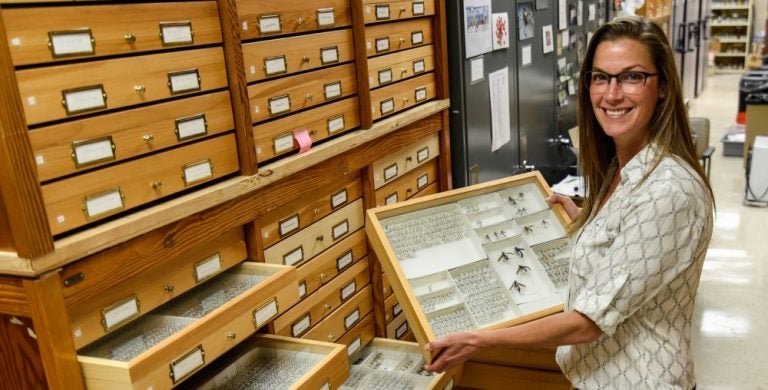The first time biology associate professor Barb Sharanowski encountered insects, they terrified her.
“When I was a kid in Ontario, Canada, my older brother used to throw them at me – gosh, it was just basically torture,” she said. “But as I grew older I overcame that fear, and curiosity took hold. I learned that they were actually the best things in the world.”
She grew up watching Quincy, M.E., a 1970s medical-mystery TV drama akin to “old-school CSI,” wanting to become a forensic pathologist like the show’s protagonist. But she soon discovered she could make a career out of her love of bugs and solving mysteries. She would “still be like Quincy, just in a more Indiana Jones way.”
Sharanowski arrived at UCF last fall after a stint at the University of Manitoba where she taught about her favorite bug: wasps. Here she teaches, conducts research and oversees the UCF Collection of Arthropods, commonly referred to as the Bug Closet.
The closet is a unique 1,800-square-foot research facility with over 510,000 insect specimens in the Biological Sciences building. The Bug Closet began in 1993 thanks to a volunteer who spent countless hours building the collection. It was housed in a closet-sized space, which led to the nickname. Over time, the collection grew exponentially as insects from Central Florida were gathered and catalogued. Many are rare, such as Lissohypnus fullertoni, a species of rove beetle, and Acroceridae, the spider fly. The closet is open to scientists around the world and tours are available to the public.
“The collection here is fantastic,” she said. “It’s lovely. I got really excited when I interviewed here and I saw all the wasps – I was, like, ‘yayyy!’”
Her specialty is a family of parasitic wasps called Braconidae. She’s participated in collection trips to Peru, Australia and Honduras, identifying new species. Aside from teaching students about these amazing creatures, the field work is what really drives her.
“They’re super diverse, more diverse than you can possibly imagine,” she said. “There are more than 19,000 species in the family of wasps I study – more than all mammals, fish, birds and reptiles combined.”
And there are lots of reasons to study wasps, beyond knowing the original story of Marvel’s Wasp character.
Some species inject a type of virus to control the behavior of other insects, causing them, for example, to protect the wasp from danger with little regard for the other insects’ own safety.
“Some time in evolutionary history, the virus became integrated into the wasp’s genome. It’s really creepy and cool stuff,” she said. “The whole movie Alien is based off of parasitic wasps. How did these wasps evolve to have this ability? That’s one of the questions I’m trying to figure out.”
Sharanowski is also developing a mobile field guide app that will help nonexperts in the agricultural industry accurately identify pests attacking their crops. The app would tie into the Bug Closet to help with identifying creatures found in the field. The app is in beta testing with an expected 2018 release date.
There are many other potential applications for the app.
“In the future I could see the app being used in forensic situations, where you need people who aren’t fully trained in entomology to be able to identify insects properly, or even in ecotourism,” she said.
